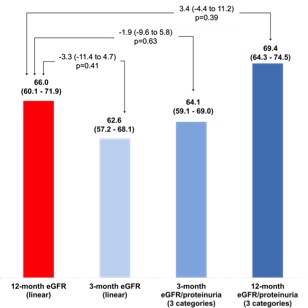The Combination of 3-Month Estimated Glomerular Filtration Rate and Proteinuria is a Valuable Tool for Evaluating Long-Term Kidney Graft Survival
1Nephrology and Kidney Transplant Unit, University Hospital of Nancy, Vandoeuvre-lès-Nancy, France, 2Clinical Investigation Center 1433, INSERM U1116, INI-CRCT, F-CRIN, Lorraine University, Vandoeuvre-lès-Nancy, France, 3Clinical Investigation Center 1433, INSERM 1116, INI-CRCT, F-CRIN, Lorraine Univeristy, Vandoeuvre-lès-Nancy, France, 4Laboratoire d’Histocompatibilité, University Hospital of Nancy, Vandoeuvre-lès-Nancy, France, 5Nephrology and kidney transplant unit, University Hospital of Nancy, Vandoeuvre-lès-Nancy, France, 6Nephrology and kidney transplant unit, INI-CRCT, F-CRIN, University Hospital of Nancy, Vandoeuvre-lès-Nancy, France
Meeting: 2019 American Transplant Congress
Abstract number: A157
Keywords: Glomerular filtration rate (GFR), Graft failure, Kidney transplantation, Outcome
Session Information
Session Name: Poster Session A: Biomarkers, Immune Monitoring and Outcomes
Session Type: Poster Session
Date: Saturday, June 1, 2019
Session Time: 5:30pm-7:30pm
 Presentation Time: 5:30pm-7:30pm
Presentation Time: 5:30pm-7:30pm
Location: Hall C & D
*Purpose: Estimated glomerular filtration rate (eGFR) measured at 1 year is the usual outcome used to predict the long-term graft survival in the field of kidney transplant (KT). Yet, acting on earlier quantification of eGFR could help the first-year KT management and might be used as reliable tool for clinical trials. We intended to evaluate the prognostic value of early (3 months) quantification of eGFR and proteinuria following KT for long-term graft survival.
*Methods: We studied 3, 6 and 12-month eGFRMDRD and proteinuria in 754 patients who underwent first KT from 2000 to 2010 (mean follow-up 8.3 years). Adjusted associations with graft survival (as defined by return to dialysis) were estimated using multivariable Cox model. Predictive accuracy was estimated using C-index and net reclassification index (NRI).
*Results: 3-month eGFRMDRD<30 mL/min/1.73m² and proteinuria were strong independent predictors of return to dialysis (respectively adjusted HR=3.65, 2.00-6.65, p<0.001 and adjusted HR ranging from 1.78 to 4.89 according to the severity of proteinuria, all p<0.05). 3-month eGFRMDRD and 3-month proteinuria significantly improved C-index and NRI over clinical variables (C-index: 4.4, 1.1-7.7, p=0.01 and 6.8, 2.1-11.5, p=0.005; NRI of respectively 12.6, 0.8 to 24.0, p=0.04 and 24.5, 13.4 to 38.5, p<0.0001). eGFR at 3 and 12 months were strongly correlated (r=0.76). eGFR and proteinuria changes from 3 to 12 months were significantly associated with return to dialysis and further improved predictive accuracy on top of 3-months variables (C-index increase: 3.5, -0.5 to 7.4, p=0.08 and 3.5, 1.5-30.7, p=0.01; NRI: 18.2, 1.5 to 30.7, p=0.03 and 25.5, -0.6 to 35.0, p=0.06). Moreover, the combination of 3-month eGFR and proteinuria had a C-index which was not significantly different than the one of 12-months eGFR to predict long term graft survival (see the comparaison of C-index in the Figure).
*Conclusions: 3-month eGFR and proteinuria are powerful predictors of long-term return to dialysis. Yet 3 to 12 months changes in eGFR and proteinuria further improve risk stratification of patients following KT. Early outcomes may be used in clinical trials with early short term therapeutic interventions in order to reduce costs.
To cite this abstract in AMA style:
Mottola C, Girerd N, Duarte K, Aarnink A, Kessler M, Frimat L, Girerd S. The Combination of 3-Month Estimated Glomerular Filtration Rate and Proteinuria is a Valuable Tool for Evaluating Long-Term Kidney Graft Survival [abstract]. Am J Transplant. 2019; 19 (suppl 3). https://atcmeetingabstracts.com/abstract/the-combination-of-3-month-estimated-glomerular-filtration-rate-and-proteinuria-is-a-valuable-tool-for-evaluating-long-term-kidney-graft-survival/. Accessed December 30, 2025.« Back to 2019 American Transplant Congress

